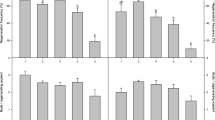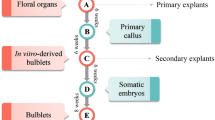Abstract
Bulbs, corms and other subterranean storage organs are commonly used as explant source material for the establishment of geophytes in vitro. The inflorescence stalk was found to be a good alternative source of explants to overcome explant contamination originating from underground storage organs. Inflorescence explants of Allium, Dichelostemma, Eucrosia, Gladiolus, Haemanthus, Hyacinthus, Narcissus, Nerine and Ornithogalum were used to establish cultures in vitro. The regeneration potential of the inflorescence was compared with regeneration from bulb twin scales or from apical buds isolated from corms. Gladiolus (Iridaceae) explants isolated from the floral stem just below the expanding florets, still enclosed in the bracts, were highly regenerative in the presence of naphthalene acetic acid (NAA) and kinetin. In the presence of 2,4-dichlorophenoxyacetic acid and benzyl aminopurine (BA) in the medium, explants isolated from the tissue at the junction between the peduncle and the pedicels of a young Nerine (Amaryllidaceae) inflorescence regenerated several buds. The scapes of young unemerged inflorescences taken from sprouting bulbs of Narcissus (Amaryllidaceae), following a 15 °C storage treatment, regenerated buds in the presence of NAA, BA, elevated phosphate and adenine sulfate in the medium. The number of buds regenerated depended on the location on the scape from which the explant was isolated, and on the duration of the 15°C treatment. In Allium (Alliaceae), capitulum tissue between the flower pedicels regenerated buds. Explants excised from the peduncle, as well as the pedicel-peduncle junction of Dichelostemma (Alliaceae), Ornithogalum, Hyacinthus (Hyacinthaceae) and Eucrosia (Amaryllidaceae) regenerated several buds in each type of explant. In the case of Haemanthus (Amaryllidaceae), pedicel-peduncle junction explants regenerated buds only when excised from inner whorl florets. Propagation protocols and the potential use of expediently isolated inflorescence explants for efficient micropropagation of geophytes are discussed.
Similar content being viewed by others
Author information
Authors and Affiliations
Additional information
Received: 1 September 1999 / Revision received: 13 December 1999 / Accepted: 13 December 1999
Rights and permissions
About this article
Cite this article
Ziv, M., Lilien-Kipnis, H. Bud regeneration from inflorescence explants for rapid propagation of geophytes in vitro. Plant Cell Reports 19, 845–850 (2000). https://doi.org/10.1007/s002990000204
Issue Date:
DOI: https://doi.org/10.1007/s002990000204




